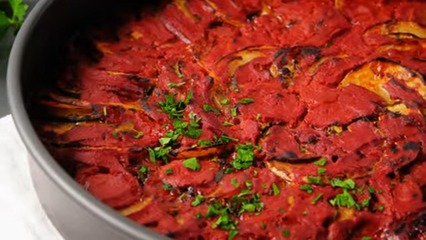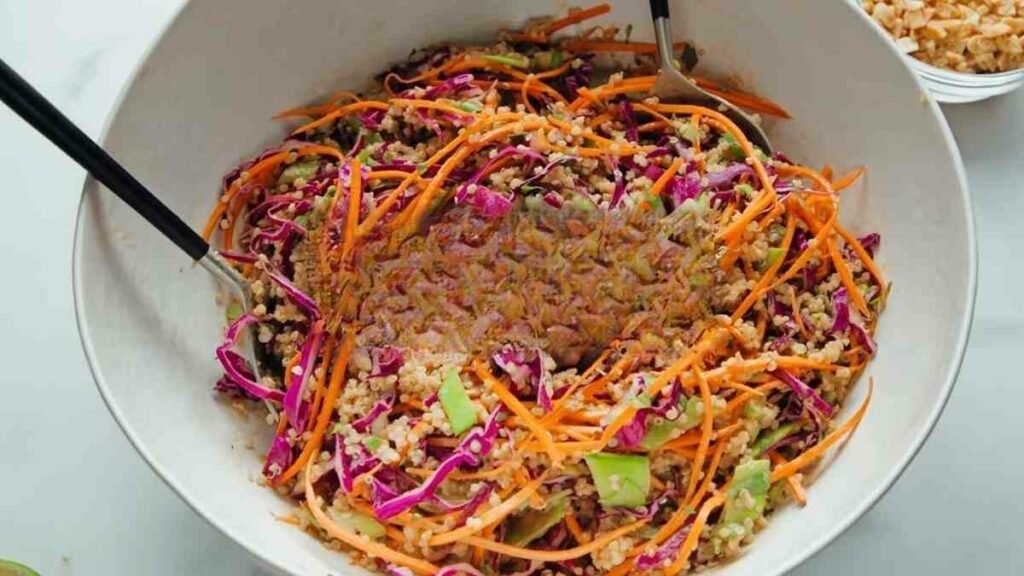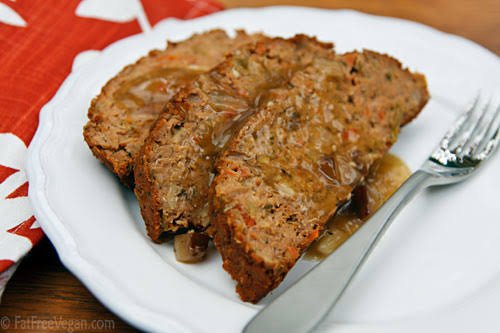Fragrant herbs like Oregano, thyme and rosemary, along with garlic, create a harmonious blend that contributes to the Briam dish recipe as a masterpiece.
Other than being a masterpiece, it is low in calories, it has antioxidant properties to protect cells from damage caused by free radicals, is high in fibre and has a traditional Greek culinary heritage.
But how can you prepare one?
Ingredients Needed For Traditional Briam Dish
Preparing a traditional Briam dish that makes you and others crave more starts with getting it right with the ingredients.
- 1 kg mixed vegetables (zucchini, eggplant, potatoes, bell peppers)
- 4 tomatoes, chopped
- 1 onion, sliced
- 4 cloves garlic, minced
- 1/2 cup olive oil
- 1 teaspoon dried oregano
- 1 teaspoon dried thyme
- Salt and pepper to taste
- 1/2 cup tomato sauce
- 1/2 cup water
- Fresh parsley for garnish (optional)
Equipment Needed for Traditional Briam Dish
Having the right equipment will contribute to getting taste and feel right.
- Baking dish: To assemble and bake the Briam dish.
- Knife: For chopping vegetables and tomatoes.
- Cutting board: To provide a surface for chopping vegetables.
- Garlic press: To mince garlic efficiently.
- Frying pan: To sauté onions and garlic.
- Wooden spoon: For stirring vegetables and ensuring even cooking.
- Measuring cups and spoons: To measure ingredients accurately.
- Oven: For baking the Briam dish to perfection.
- Mixing bowl: Toss vegetables with herbs and spices.
- Serving platter: To present the finished Briam dish.
- Optional: Fresh parsley for garnish – a chopping board and knife may be needed.
Guide on Preparing Traditional Briam Dish
From the meticulous selection of vegetables to the aromatic blend of herbs, each step is crucial in bringing this dish to life.
Step 1: Check That All Ingredients are Ready
After you’ve checked, the next thing to do is preheat your oven to 375°F (190°C). Have your potatoes washed and peeled, cut into thin slices.
Don’t forget to have the Zucchini, eggplant, and bell peppers clean and chopped into bite-sized pieces.
Step 2: Mix Your Vegetables
Are the Zucchini, eggplant, and bell pepper properly chopped? If yes, it is time to mix them in a large bowl and make sure they are evenly distributed.
Step 3: Make a Tomato Mixture
The next thing to do is mix chopped tomatoes, olive oil, dried Oregon, pepper, salt, minced garlic and dried thyme in a separate bowl.
It should be done properly as it helps form a flavorful tomato mixture.
Step 4: Coat your Vegetables
Pour the tomato mixture over the chopped vegetables. Toss the vegetables until they are evenly coated with the tomato mixture.
And don’t forget to transfer the coated vegetable mixture to a baking dish, spreading it out evenly.
Step 6: Mix with Sauce
In a small bowl, mix the tomato sauce with water. Pour this sauce over the vegetables in the baking dish. This adds moisture and enhances the flavour.
Step 7: Start Baking
Cover the baking dish with aluminium foil. Bake in the preheated oven for approximately 45-60 minutes, or until the vegetables are tender.
You can remove the foil during the last 15 minutes of baking to allow the top to brown slightly.
Step 8: Garnish and Serve
Once cooked, you can garnish the Briam with fresh parsley for a burst of freshness and added visual appeal.
Serve the traditional Briam dish hot. It can be enjoyed as a satisfying main course or as a flavorful side dish complementing your meal.

Traditional Briam Dish Recipe
Ingredients
- 1 kg mixed vegetables (zucchini, eggplant, potatoes, bell peppers)
- 4 tomatoes, chopped
- 1 onion, sliced
- 4 cloves garlic, minced
- 1/2 cup olive oil
- 1 teaspoon dried oregano
- 1 teaspoon dried thyme
- Salt and pepper to taste
- 1/2 cup tomato sauce
- 1/2 cup water
- Fresh parsley for garnish (optional)
Instructions
- Preheat your oven to 375°F (190°C).
- Wash and peel (if necessary) the vegetables. Cut them into evenly-sized chunks. Combine zucchini, eggplant, potatoes, and bell peppers in a large mixing bowl.
- In a separate bowl, mix together chopped tomatoes, sliced onion, minced garlic, olive oil, dried oregano, dried thyme, salt, and pepper. Toss the vegetable mixture with this sauce until well coated.
- In a baking dish, arrange the coated vegetables evenly.
- Pour the tomato sauce and water over the vegetables. Ensure the sauce is evenly distributed.
- Cover the baking dish with aluminum foil and bake in the preheated oven for about 45 minutes or until the vegetables are tender. You can uncover for the last 15 minutes to allow the top to brown slightly.
- If desired, garnish with fresh parsley before serving. Remove from the oven and let it cool for a few minutes. Serve the Traditional Briam Dish as a delicious and hearty main course.
Video
Tips for Preparing The Briam Dish
Some rules and laws govern a country, and so are tips to get it right with traditional briam dishes.
1. Selecting the Freshest Ingredients
Opt for firm zucchini, glossy eggplants, and potatoes without blemishes. The quality of your ingredients lays the foundation for a flavorful dish.
2. Uniform Vegetable Cuts
This ensures that each element of your Briam reaches the desired tenderness simultaneously, creating a perfectly balanced medley.
3. The Power of Seasoning
Allow the vegetables to marinate in a mixture of olive oil, garlic, dried oregano, dried thyme, salt, and pepper. This step infuses each bite with the rich, aromatic essence of Mediterranean herbs.
4. Layering for Optimal Flavor Infusion
When arranging your vegetables in the baking dish, think of it as creating layers of flavour. Alternating the vegetables with the seasoned tomato sauce ensures that each piece absorbs the delicious essence, resulting in a harmonious blend of tastes.
5. Slow-Baking Magic
The key to a perfect Briam lies in patience. Slow-bake the dish to allow the vegetables to absorb the flavours and develop a satisfying tenderness. Cover the dish with foil for most of the baking time, removing it towards the end to achieve a golden, caramelized finish.
6. Garnish with Fresh Herbs
For a finishing touch, consider garnishing your Briam with fresh parsley. This not only adds a burst of colour but also contributes a layer of freshness to the dish, balancing the robust taste.
What to Serve With Briam Recipe
From bread to refreshing salads, there are other dishes for you to have with your Briam dish.
- Crusty Bread: A loaf of crusty artisan bread is perfect for soaking up the delicious juices.
- Feta Cheese: Add a touch of tanginess with crumbled feta cheese sprinkled on top.
- Greek Salad: Refreshing and crisp, a Greek salad with tomatoes, cucumbers, olives, and feta pairs beautifully.
- Tzatziki Sauce: The cool and creamy tzatziki sauce is an excellent dip for added freshness.
What is the significance of slow-baking in the Briam preparation?
Slow-baking helps in improving the dish’s flavours by making sure ingredients like tomatoes, zucchini, and potatoes release their natural juices slowly.
Additionally, slow baking promotes the caramelization of sugars present in the vegetables, contributing to a subtle sweetness and a deep, complex aroma. The gradual cooking process also allows the vegetables to maintain their integrity, ensuring a tender yet hearty texture. The significance of slow baking in Briam lies in its ability to transform simple ingredients into a harmonious and satisfying culinary experience, showcasing the essence of Mediterranean cuisine.
How can I adjust the seasoning to suit my taste preferences?
To tailor the seasoning to your taste preferences, start by adding small amounts of the specific seasonings you desire, such as salt, pepper, herbs, or spices. Taste the dish after each addition to gauge the impact on how it comes out. Remember that it’s easier to add more seasoning later than to fix an overly seasoned dish.
Consider the overall balance – adjust the saltiness, spiciness, and acidity to achieve a harmonious flavour profile. If a dish is too salty, try balancing it with a squeeze of lemon or a pinch of sugar.
To enhance depth, experiment with complementary herbs or spices. Don’t hesitate to get creative and trust your palate. Regularly tasting as you adjust will help you find the perfect balance to match your personal preferences.


















